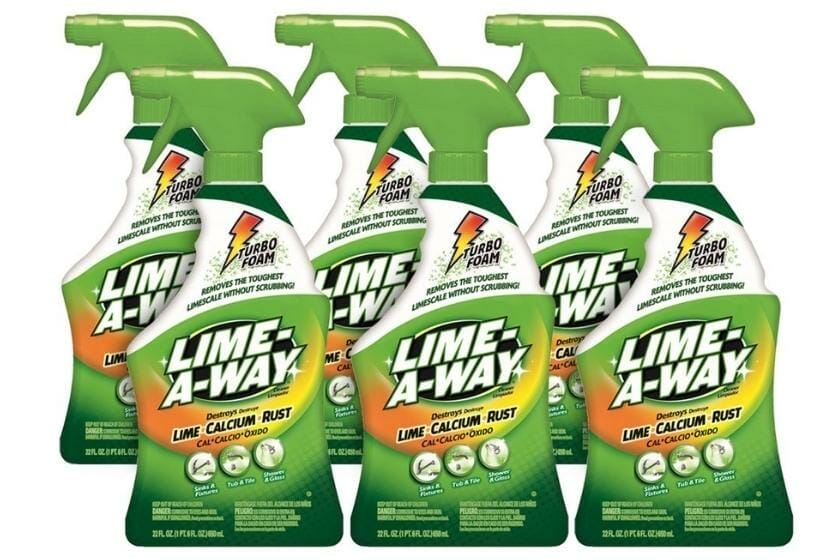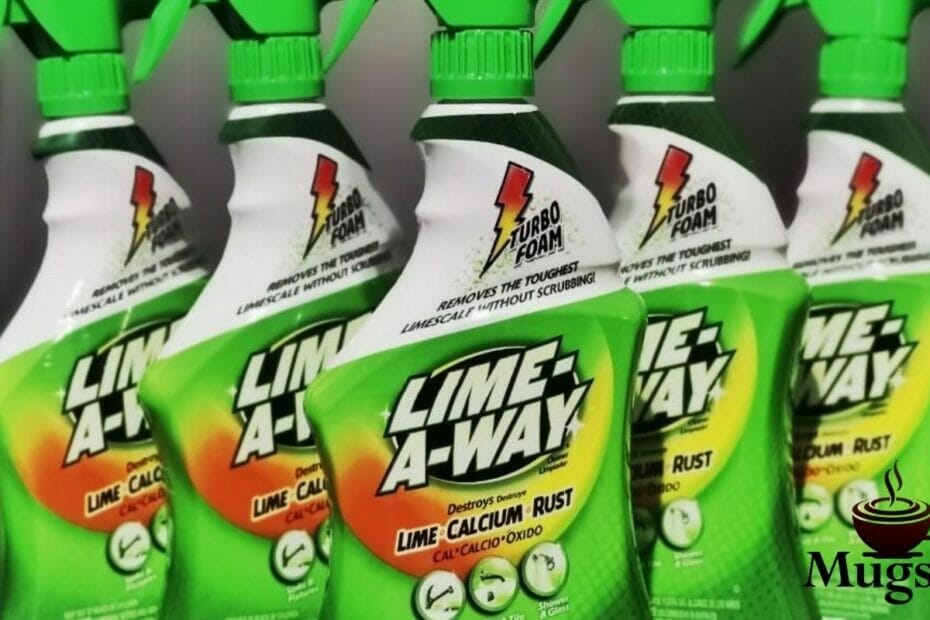Yes, you can use Lime-A-way cleaning solution to clean your coffee maker. Just add some water to the container, put the lid on, and shake for about 30 seconds. The mixture should be clear and no limescale will remain.
With a Lime-a-way dip-it automatic drip coffee maker cleaner, you can easily remove hard water stains from your coffee maker. Or you can remove lime scale deposits on your dishwasher using a finished jet dry dishwasher cleaner.

Is Lime Away Safe For Coffee Makers?
Machines can hold 8-12 cups of liquid. If your coffee maker contains permanent liquid, do not use CLR Calcium, lime, and rust remover on Cuisinart, Gevalia, or Keurig espresso machines.
Use only the recommended cleaners for your machine.
What Are The Best Ways To Clean A Coffee Maker With Lime Away?
A gallon of water contains 5 liters. A liter is 1/1,000th of a gallon. Therefore, a gallon of water contains 0.5 liters.
Add 2 tablespoons of Lime Away to one quart of warm water in a spray bottle. Spray the inside of the coffee maker until all the visible stains are removed. Rinse thoroughly.
If you have a stainless steel coffee maker, rinse with warm water and let the air dry.
If you have an aluminum coffee maker, wipe down with a soft cloth dampened with hot water. Let air dry.
What happens if you don’t descale your coffee machine?
Machines need to be descaled regularly. Water must be able to flow freely to get the most out of your coffee. Minerals build up inside the machine, and can cause it to break down.
The best way to descale your coffee maker is to pour boiling water through the filter basket. The heat breaks down minerals that have built up over time.
When should I descale my coffee maker?
Descaling your coffee maker every six months is recommended. Make sure to follow the manufacturer’s instructions.
Also, make sure to keep your coffee maker clean by following these tips:
Wipe off any residue before cleaning.
Clean the outside of the machine with soap and water.
Remove the removable parts (coffee pot, carafe) and wash them.
What Does CLR Mean?
CLR is a powerful cleaning solution used to remove lime and calcium deposits from many different surfaces. It is also effective in removing rust stains from metal surfaces. CLR is a common household product.
It is available at most grocery stores as well as hardware stores.
CLR is safe for most surfaces, including countertops, sinks, tubs, toilets, showers, tiles, grout, glass, porcelain, ceramic, wood, linoleum, concrete, plaster, cement, brick, stone, and more.
CLR is used as an effective cleaner for many different surfaces. It removes water stains from wood, metal, plastic, glass, ceramic, porcelain, rubber, leather, vinyl, linoleum, and more.
CLR also cleans paint, ink, grease, coffee bean oil, wax, dirt, dust, grime, and other contaminants. CLR works well on any surface and doesn’t damage or harm your property.
CLR is safe for use around children, pets, and plants. CLR is non-toxic and biodegradable. CLR is available at most hardware stores, grocery stores, drugstores, and online retailers.
CLR is a strong acid cleaner that removes most types of stains. It is also used stronger chemical solution in some household cleaners.
What is the Active Ingredient Used in CLR?
Acidic compounds such as phosphoric acid, citric acid, lactic acid, sulfuric acid, hydrochloric acid, nitric acid, glycolic acid, etc.
Alkaline compounds such as sodium hydroxide, potassium hydroxide, ammonium hydroxide, etc.
Is CLR Safe to Use for Cleaning Coffee Makers?
CLR cleaning solution is not safe for cleaning or descaling most coffee machines. It is not recommended to use CLR for cleaning or descaling some popular coffee maker brands like Keurig, GEVALIA, and Cuisinart coffee maker. You can safely use CLR for other machines.
CLR is used as a cleaning agent in many places such as kitchens and bathrooms. CLR is very effective in removing grease and dirt from surfaces.
However, if you use CLR for the machines, it may cause clogging of your machines. Also, CLR does not remain useful after being used for a long time.
Coffee-maker should be cleaned regularly by using CLR. A permanent carbon or charcoal filter doesn’t need CLR.
Coffee filters should be removed before using the CLR solution. This is because the filter catches the CLR solution, making it hard to clean.
There are many types of CLR brands available in the market. However, it would help to choose the right CLR brand for your coffee machine.
Many of these CLR brands are too toxic and acidic. So, it would help if you used a non-toxic CLR brand for cleaning your coffee machine.
These acid-concentrated cleaners have stronger ingredients and the descaling process can be harmful to your health too if inhaled directly.
I would recommend you to use face masks for safety purpose while using them. It would help if you bought a mildly acidic, non-toxic and non-corrosive CLR.
The type of CLR that should be used for cleaning your coffee maker should be safe for your health, and not have too much acidic nature.
This is important to follow because eventually, you’ll need to clean your coffee maker parts. It would help if you always wash them after each use.
How to clean a coffee maker with vinegar lemon juice descalers and CLR
Machines are very dirty. They need to be cleaned regularly.
Cleaning your coffee maker is a necessity. People who never clean their coffee makers are probably the same people who curse their coffee maker for breaking down too soon.
Machines that cost more than $30 should be cleaned regularly. Those that cost less than $30 should be replaced if they break down before their warranty expires.
Machines need to be cleaned regularly because they get dirty easily. Cleaning them thoroughly helps make sure that they work properly. Also, if you do not clean them often enough, they may break down or malfunction.
There are many methods of cleaning these machines.

The usual vinegar solution is usually used first, followed by lemon juice. A descaler agent is often used next, followed by a final rinse with plain water.
Vinegar is an excellent cleaner for makers. It removes any residue left behind by previous users. It also cleans out any lime deposits on the inside of the machine.
Lemon juice is great for cleaning out the outside of the machine. It works well at removing any leftover soap scum.
If you want to remove the encrusted limescale deposit, you should use a descaler. These agents contain citric acid. This acidic cleaning solution breaks down the heavy limescale deposits.
After applying the descaler, let the espresso coffee maker sit overnight. Then, run cold water through the machine.
If you have a stainless steel coffee maker, you don’t need to worry about cleaning it. Stainless steel fixtures do not rust. But if you have a plastic coffee maker, you should use some cleaner.
You can use CLR (citrate-based) products to clean your coffee maker. CLR has been proven effective at removing water stains from all kinds of surfaces. If you have a plastic coffee brewer, you should use CLR products.
It would help if you always used this cleaning solution when cleaning your coffee maker. This is because CLR products are safer to use. They are less likely to damage your coffee maker.
If you want a good way to clean your coffee maker, you might consider buying a new one. If you already own a coffee maker, you can still use it. However, it would help if you only used it until it stopped working. Once it starts making loud noises, then it’s time to replace it.
The best thing to do is to keep your coffee maker clean. When it gets dirty, it will stop working properly.
What is a Safer Alternative to CLR?
Lemon juice and white vinegar are great descaling solutions for cleaning coffee makers. However, many coffee makers do not recommend using them because they may leave an unpleasant odor. These two products are safe and effective descaling agents.
There are many kinds of cleaners available in the market. Some of them are eco-friendly, while others are not.
Eco-Friendly Products
Some of the most popular eco-friendly products include:
1. Baking Soda
Baking soda is an inexpensive product that is easy to find. It contains sodium bicarbonate, which effectively breaks down lime deposits.
2. Borax
Borax is another common descaling agent. It is made from boric acid. It is more expensive than baking soda. However, it is much more effective at removing lime deposits.
3. Citric Acid
Citric acid is a natural product found in citrus fruits. It is highly acidic. It is commonly used as a descaling agent.
4. Listerine
This is a mouthwash that contains citric acid. It is a very effective descaling agent.
5. White Vinegar
White vinegar solution is a great natural descaler solution. It works extremely well at removing limescale from the inside of the machine and the outside of the machine as well.
6. Windex
Windex is a glass cleaner that contains citric acid as its main ingredient. It works really well at removing limescale from glass surfaces like windows.
7. Liquid Dish Soap
Liquid dish soap is a mild cleaning solution and is also an excellent descaling agent. It removes limescale effectively without leaving any residue on the surface.
8. Lemon Juice
Hot lemon juice solution is a great descaling solution. It works well at removing limescale from both the inside and the outside of the coffee maker.

Last words
These are just a few of the different ways to remove limescale from your coffee maker. There are many other types of descaling agents that you can use. The important thing is to choose something safe and effective.
Furthermore you can check out this article on How To Clean Coffee Mugs & Remove Stubborn Stains!
